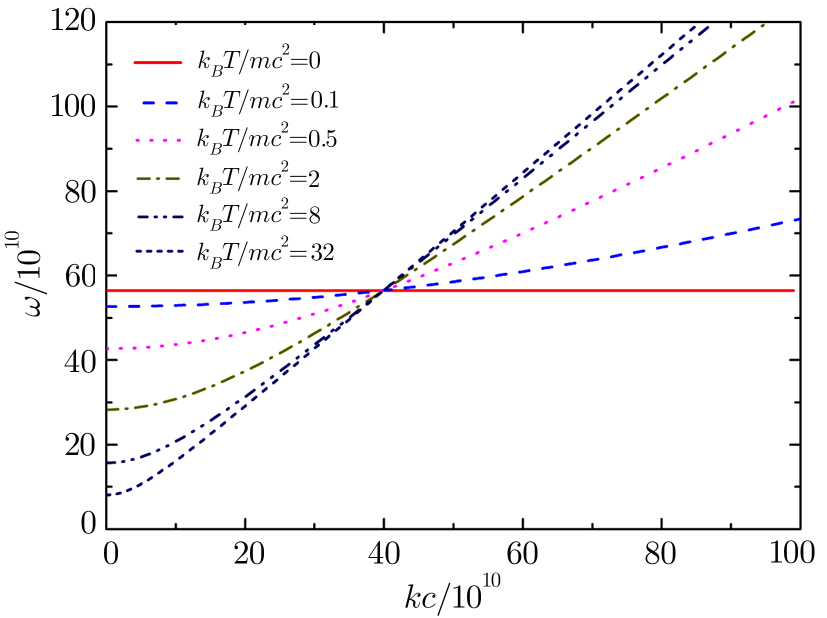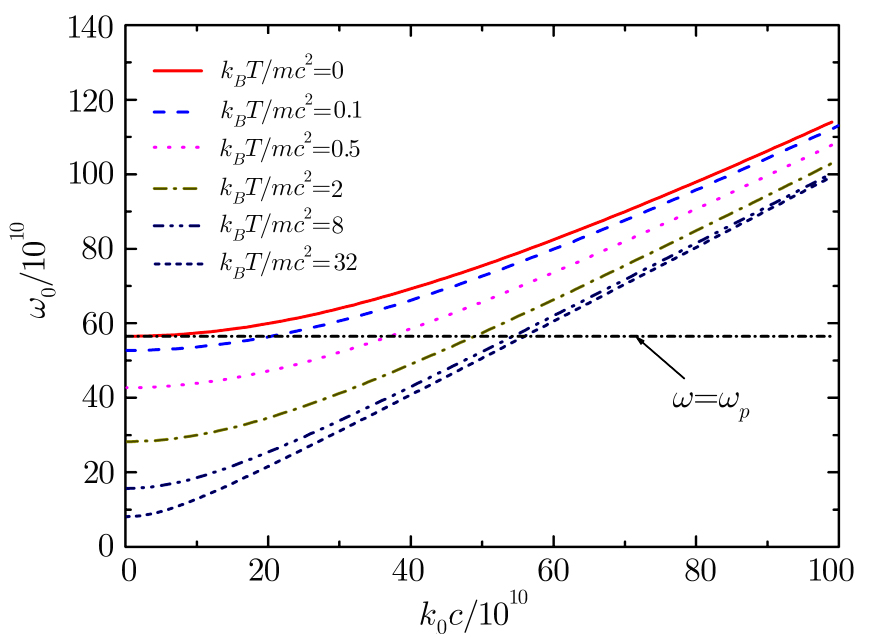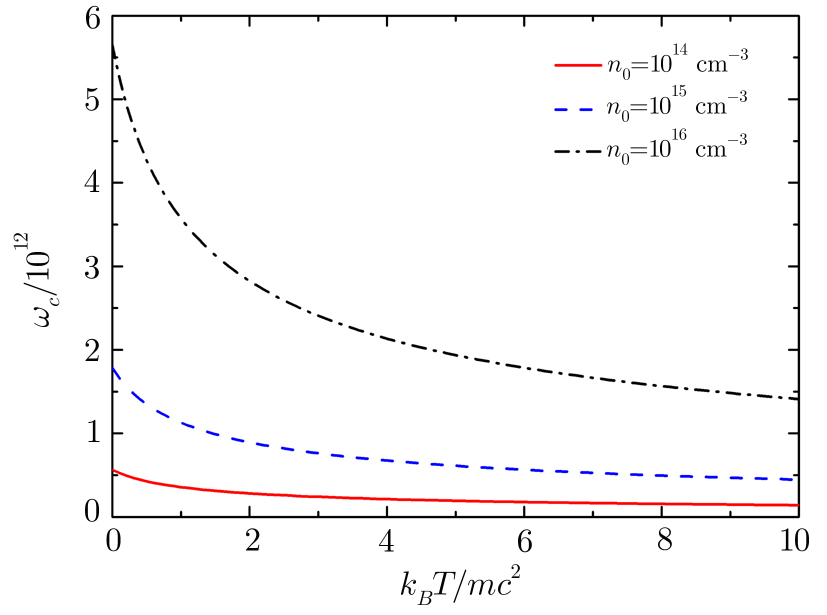† Corresponding author. E-mail:
Supported by the National Natural Science Foundation of China under Grant Nos. 11064005 and 51460020, and the financial support provided by the Key Subject of Atomic and Molecular Physics in Jiangxi Province (2011-1015).
The linear Langmuir and electromagnetic (EM) waves in relativistic hot plasmas are discussed, and the dispersion relations are obtained based on the covariant Maxwell’s and fluid equations. When kBT/mc2 ˃ 1, the effective mass of electrons will be increased obviously. As the results, many other influences are induced, such as the decrease of the plasmas frequency and the critical frequency, the reduction of the electron sound velocity and the electrons’ oscillation velocity, and so on. Numerical results show that these influences can affect the dispersion relations of Langmuir and EM waves seriously even in linear regime.
Previous studies in laser-plasmas interactions discovered many interesting phenomena, such as filamentation,[1–2] modulation instability,[3–4] stimulated Raman scattering,[5] and so on. Most of the analyses of these phenomena assumed electrons’ thermal energy much small compared to their rest energy, i.e., kBT ≪ mc2, where kB is the Boltzmann constant, T is the plasmas temperature, m is the rest mass of electron, and c is the light speed in vacuum. These kinds of plasmas are the so-called cold or warm plasmas. However, in some particle-in-cell (PIC) simulations of kJ class laser channeling in mm scale underdense plasmas for fast ignition, the residual electron temperature T in the channel was found to be multi-MeV, i.e., kBT ˃ mc2.[6–7] Relativistic T was also observed in PIC simulations with sub-ps intense pulses of energy as low as 10 J.[8] Recently, a plasma as hot as a few tens of MeV has been numerically demonstrated by using the state of the art high-power laser facilities.[9] Furthermore, it is also believed that the relativistic hot plasma existed widely in the early period of evolution of the Universe.[10]
The relativistic effect of the random motion can increase the effective mass of the charged particles. It will trigger a series of changes in the laser-plasmas interaction, such as decrease the plasmas frequency, reduce the electron oscillation velocity, decouple the laser from the plasmas, and so on.[6–8] Finally, these variations will affect a wide range of plasma optical phenomena in intense laser-plasma interaction.[10–14] In present, how relativistic T affects the plasma optical process still remains largely unexplored.[12]
The theoretical approach to analyse the relativistic hot plasmas need a fully and coherent relativistic plasma equations, and which has been established.[10,13] Most of the earlier studies ignore completely relativity in the continuity equation or work only in the weak relativity approximation in which the relativistic effects are taken into account making use of a motion equation obtained by simply substituting the velocity of species
In this letter, we analyse the Langmuir and EM waves in relativistic hot plasmas linearly based on the fully and coherent relativistic plasma equations and Maxwell’s equations. The dispersion relations are obtained. We will show that in the relativistic hot plasmas, the increase of the electron effective mass reduce the electron sound velocity and critical frequency as well as the electron oscillation velocity and the plasmas frequency. Numerical results show that these variations can affect the dispersion relations seriously.
The fluid equations used to describe the dynamics of fully relativistic plasmas and the EM field equations for the scalar and the vector potentials can be obtained from the conservation of the particle number and the energy-momentum tensor for each species of plasmas, and can be written as,[10,13,16]






Equations (










In present paper, we focus on discussing the temperature effects on the linear Langmuir and EM waves in the relativistic hot plasmas, and the nonlinear phenomenon will be discussed in the following papers. Accordingly, we write the physical quantities as 







In the following, we assume that the equation of state contrasts with the adiabatic equation,[13,16] i.e., the polytropic index α reduces to the adiabatic index.
The divergence of Eq. (








In warm plasmas, i.e., kBT/mc2 ≪ 1, Eq. (


Considering the Langmuir wave is a plane wave and the compression is one-dimensional, α = 3 is used in the numerical calculation. Figure
 | Fig. 1 (Color online) Dispersion plots for Langmuir wave with different plasmas temperature. The parameters n0 = 1014 cm−3 and α = 3 are presumed. |
In the uniform plasmas, neglecting the variation of plasmas density, i.e., letting ϕ1 = n1 = 0, Eq. (

Considering h0 ˃ 1, Eq. (
Substituting Eq. (




Assuming a plane EM wave propagating in relativistic hot plasmas, the numerical result is shown in Fig.
 | Fig. 2 (Color online) Dispersion plots for linear EM wave with different plasmas temperature. The parameters n0 = 1014 cm−3 and α = 3 are presumed. |
Letting k0 = 0, the critical frequency of EM wave propagating in plasmas can be obtained from Eq. (

Figure
In relativistic hot plasmas, the increase of effective mass caused by the random motion of electron can trigger a series of influences on various physical processes, including linear and nonlinear processes. In the present paper, we have examined the influence of the effective mass increase on the linear Langmuir and the EM waves. The dispersion relations are obtained. Results show that when kBT/mc2 ˃ 1, the effective mass of electrons will be increased obviously. This increase not only depends on the relativity of the electrons’ random motion, but also depends on plasmas density and polytropic index. Furthermore, the effective mass increase will induce many other changes, such as the decrease of the plasmas frequency and the critical frequency, the reduction of the electron sound velocity and electrons’ oscillation velocity, and so on. Numerical results show that these variations have a strong impact on the propagation of linear Langmuir and the EM waves in relativistic hot plasmas.
| [1] | |
| [2] | |
| [3] | |
| [4] | |
| [5] | |
| [6] | |
| [7] | |
| [8] | |
| [9] | |
| [10] | |
| [11] | |
| [12] | |
| [13] | |
| [14] | |
| [15] | |
| [16] | |
| [17] |


